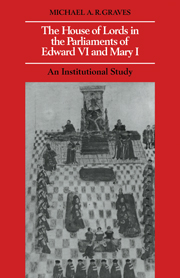Book contents
- Frontmatter
- Contents
- Dedication
- Preface
- Parliamentary sessions, 1547–8
- 1 Introduction
- 2 The composition of the House
- 3 The quality of the House
- 4 Attendance and activity, absenteeism and management
- 5 Cohesion and division
- 6 The Lords' inheritance: clerks and assistants to the House
- 7 The rules of business: procedure
- 8 The legislative record of the mid-Tudor Lords
- Abbreviations
- Appendix A Composition
- Appendix B Roll of the ‘actual’ members of the House of Lords, 1547–58
- Appendix C Attendance
- Appendix D Legislation
- Notes
- Select bibliography
- Index
1 - Introduction
Published online by Cambridge University Press: 03 May 2010
- Frontmatter
- Contents
- Dedication
- Preface
- Parliamentary sessions, 1547–8
- 1 Introduction
- 2 The composition of the House
- 3 The quality of the House
- 4 Attendance and activity, absenteeism and management
- 5 Cohesion and division
- 6 The Lords' inheritance: clerks and assistants to the House
- 7 The rules of business: procedure
- 8 The legislative record of the mid-Tudor Lords
- Abbreviations
- Appendix A Composition
- Appendix B Roll of the ‘actual’ members of the House of Lords, 1547–58
- Appendix C Attendance
- Appendix D Legislation
- Notes
- Select bibliography
- Index
Summary
It should be stressed at the outset that this is an institutional rather than a political study. Its particular institutional emphasis is the consequence chiefly of past neglect by historians who have persistently ignored the fact that parliament was a trinity. At best the House of Lords has been treated as a kind of constitutional longstop or a compliant managerial tool wielded by the Crown; at worst it has received a cursory nod of recognition before being consigned to oblivion. However, the comfortable assumption that it could be thus dismissed derived from ignorance, and not from a considered judgement arrived at by a systematic study of its parliamentary performance. More reprehensible, though doubtless a natural consequence of this assumption, is the fact that no attempt has yet been made to answer questions which are of elementary yet fundamental importance: how it carried out its functions, why legal assistants were summoned to the Lords, and what contribution they made to its business. It is surprising that, as the role assigned to it was a subordinate and managerial one, no detailed study was made even of the way in which it performed this supposed service to the Crown. The first responsibility of any pioneering study of the House of Lords is therefore to compensate for this past neglect. Information must be collected, collated and systematically presented about such obvious institutional characteristics as its composition and the rights of membership, the officers of the House, the legal assistants, its procedures and their continuing refinement.
- Type
- Chapter
- Information
- The House of Lords in the Parliaments of Edward VI and Mary IAn Institutional Study, pp. 1 - 8Publisher: Cambridge University PressPrint publication year: 1981

